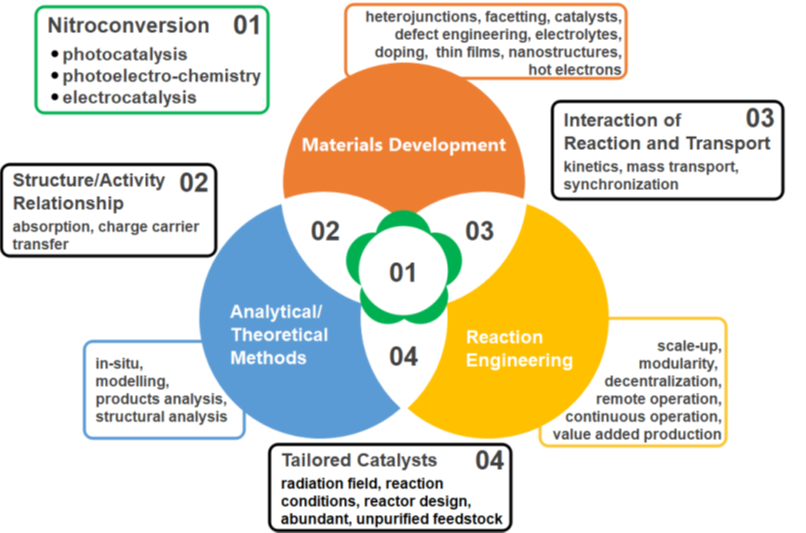Research Objective
In view of the increasing CO2 concentration in the atmosphere, ongoing energy transition, and the development of alternative concepts for the activation of small molecules, new approaches for artificial N2 conversion are in demand. This includes (photo)electrocatalysis or photocatalysis, which can be operated decentralized under less harsh conditions powered by renewable electricity or light. Although intensely researched, the overall energy demand for the conversion of N2 is still significantly higher, and the space-time yield is far too low to compete with the Haber-Bosch process. Notably, scales of the overall catalytic processes from the nanometer to the meter level are in most cases investigated isolated from each other which hampers a breakthrough.
The Priority Programme (PP) 2370 focuses on the development of heterogeneous
- electrocatalytic,
- photocatalytic &
- photoelectrochemical

N2 conversion reactions for delocalized and sustainable N2 conversion pathways with, as a long term objective, an overall energy consumption and space-time yield comparable to the Haber-Bosch process. This will be achieved by getting insights into structure/activity relationships for catalysts including experimental and theoretical design strategies, developing novel reactor and electrode concepts to overcome N2 mass transfer limitations, and by using novel analytical techniques to get insights into underlying mechanisms to be able to design catalysts rationally, and to develop new reaction pathways. It is explicitly not limited to N2 conversion to NH3 but also includes research on oxidative conversions. Molecular catalysts and molecular catalysts immobilized on surfaces are not part of this PP2370.
Especially the following aims are key within the PP2370:
- Investigation of structure/activity relationships for catalysts including experimental and theoretical design strategies
for heterogeneous electro-, photoelectro- and photocatalysts. - Rational reaction engineering to overcome the N2 mass transport limitation and to facilitate the conversion of N2 to NH3. Since a catalyst is only as good as its reaction environment, this also includes novel reactor and electrode concepts
- Development of novel analytical techniques to enable catalyst screening or insight into the underlying processes
to foster the process design. - Adapting fundamentals of the Haber-Bosch process in electro-, photo- and photoelectrocatalysis. Likewise, finding reaction pathways towards N2 activation is another aim of this programme.
- Finding alternative reactions to activate N2 either by reductive or oxidative processes.
To fulfil the objectives of this programme, the following basic and hitherto unresolved questions are addressed for N2 conversion reactions:
- What are the fundamental demands towards functional electrocatalyst?
- What key properties need to be fulfilled to establish photo-/photoelectrocatalysts?
- Can any correlation be deduced between electro- and photocatalysts leading to common design strategies?
- How can the local N2 concentration at the catalyst be increased and the competing H2 formation suppressed?
- What operation conditions need to be fulfilled to maximize space-time yield and energy efficiency?
- What strategies can be used to cope with the fluctuating nature of solar and electric energy supply?

The PP2370 aims for the systematic analysis and improvement of an overall process of N2 conversion. Only strong collaborative and interdisciplinary efforts coordinated in the PP2370 can pave the way for such a development. Especially the importance of implementation of reaction engineering right in the development of the fundamental processes cannot be stressed enough. Therefore, the different aspects ranging from the nm-scale to the m-scale are interwoven, as in every heterogeneous catalytic process. Research teams that combine different expertise are formed to address materials, engineering and analytical fundamentals. Researchers at all stages of their career are part of this PP.
